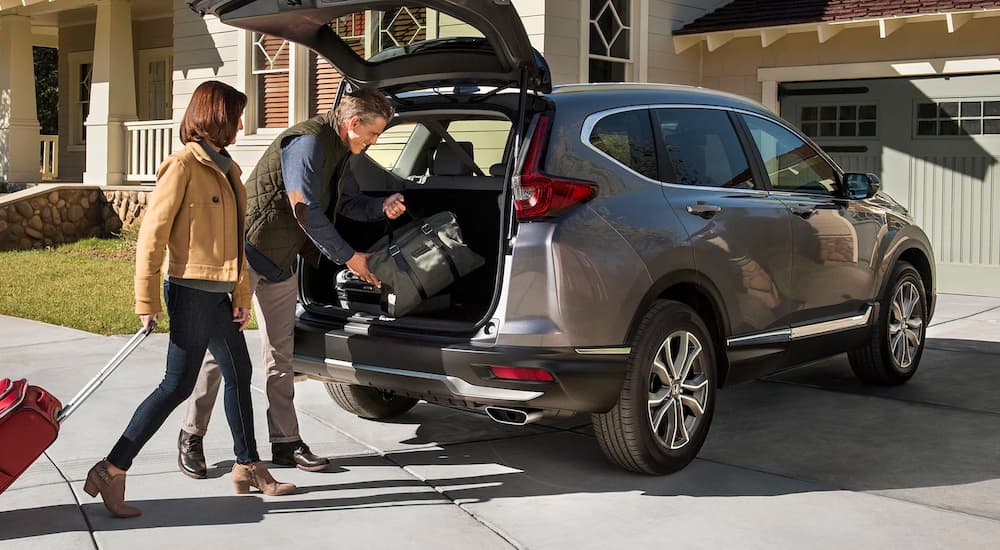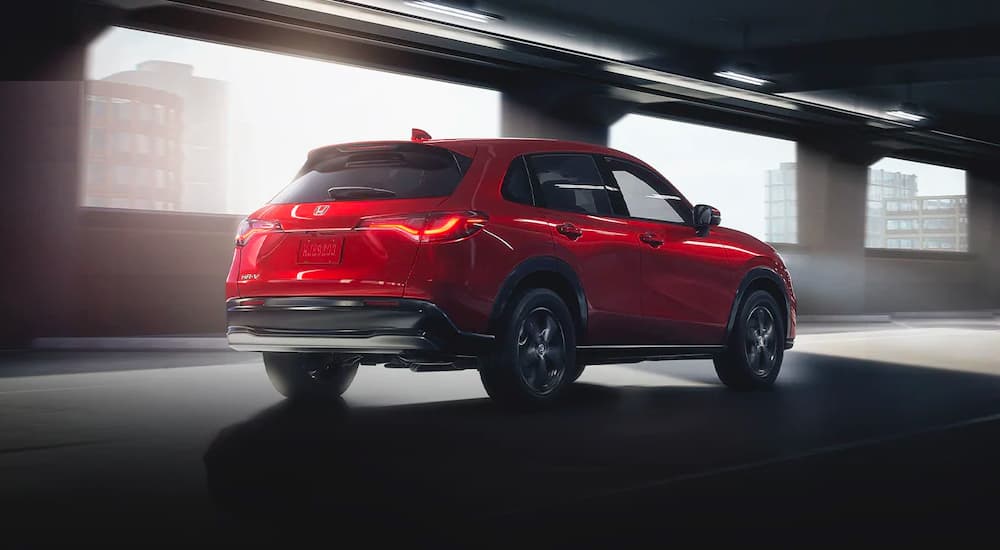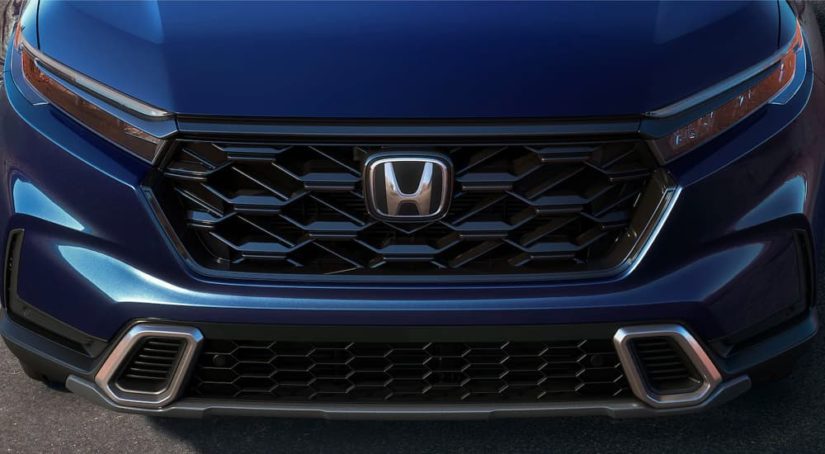Many drivers are drawn to full-size SUVs that are practical for their large families and cargo-hauling needs, from managing weekly groceries, kids’ backpacks, and sporting equipment to luggage and other gear. However, not every driver needs a land yacht, and automakers like Honda are happy to oblige. As a result, the crossover segment is bursting at the seams with models that promise the best of both worlds: sedan-like efficiency and sport handling accompanied by a dash of versatility, impressive agility, and plenty of luxuries.
These characteristics are at the heart of the CR-V and HR-V found on Honda dealer lots nationwide. The CR-V is well-established as one of the original crossovers in the industry and, as Honda claims, has a track record as its best-selling SUV for over two decades. In contrast, the HR-V is much newer to the lineup but shares the same platform and many features as the CR-V. So, how are they different, and how can you determine which crossover best suits you?
#1 Histories
The CR-V is a veteran in the Honda fleet, introduced in the late 1990s as a new type of SUV. Dubbed the “Comfortable Runabout Vehicle,” the CR-V might have debuted as an SUV, but it broke the mold by every standard. It wasn’t a traditional SUV, nor was it a sedan. Instead, it joined the Toyota RAV4 as one of the first in a new segment that would soon be known as “crossovers.”
The CR-V helped introduce and set new standards in its class, often lauded for its versatility, efficiency, and affordability. It’s been Honda’s best-selling crossover for the last 25 years, with six generations under its belt. But, in 2016, the CR-V made room in the lineup for a sibling, the HR-V. The youthful HR-V hasn’t had as much time to make the same lasting impression, but its many similarities with the CR-V in 2023 make it hard to deny it will likely share the same trajectory of success.
#2 Dimensions
While the CR-V and HR-V are crossover SUVs, their dimensions put them in different categories, even with the models sharing the same platform for 2023. The CR-V is a compact crossover and, as its name implies, is larger than its subcompact sibling. But what does this size difference look like in terms of practicality, like hauling passengers and cargo?
The CR-V and HR-V see significant redesigns for 2023, with Honda stretching the models to give them more aggressive, sportier stances and to improve cabin size. The 2023 CR-V sits on a 106.3-inch wheelbase and measures 184.8 inches long, 73.5 inches wide, and 66.5 inches tall. In contrast, the 2023 HR-V is smaller in every category, with its 104.5-inch wheelbase, 179.8-inch length, 72.4-inch width, and 63.8-inch height.
The differences seem minimal until you consider how they affect the cabin. Both offer seating for five, but the CR-V offers more spacious accommodations for front and second-row passengers. For example, its passenger capacity measures 103.5 cu.ft., whereas the HR-V’s passenger capacity is significantly less at 98.7 cu.ft.. However, you and your copilot have more room in the HR-V, which offers 1.2 inches more headroom and 0.6 inches more legroom. This makes the HR-V ideal for couples or individuals but gives the CR-V an advantage among those who need to use the second row, which offers significantly more legroom (41 inches).

#3 Cargo Capacities
As you consider your driving needs, think about how much and what type of cargo you haul. The CR-V and HR-V are both practical and versatile. Still, the CR-V’s larger wheelbase and broader width give it an undeniable advantage for drivers who haul everything from groceries and luggage to small equipment and other gear. Its total cargo volume is 76.5 cu.ft., with 39.3 cu.ft. behind the second row. In contrast, the HR-V doesn’t offer nearly as much room, with 55.1 total cu.ft. and 24.4 cu.ft. with the second row in use.
#4 Powertrain and Performance
The HR-V and CR-V see significant improvements to their powertrain lineups for 2023 to enhance responsiveness, handling, and efficiency. The smaller HR-V comes standard with Honda’s updated 2.0L four-cylinder engine and continuously variable transmission that delivers 158 horsepower and 138 lb-ft of torque, enough power to make the subcompact crossover engaging and fun to drive. As expected, the compact CR-V offers more power to accommodate its larger size, with its standard 1.5L turbocharged four-cylinder engine churning out 190 horsepower and 179 lb-ft of torque.
One notable advantage the CR-V has over the HR-V is the availability of a hybrid powertrain. The CR-V Sport and Sport Touring are dedicated hybrids with a 2.0L four-cylinder engine and dual electric motors that produce 204 horsepower combined. The hybrid pairing is exceptional, pushing the CR-V to an average fuel economy of 40 MPG in the city and 34 MPG on the highway.
Beyond powertrains, the CR-V and HR-V also introduce their first-ever selectable drive modes. The three-mode system lets you tailor how the SUV responds and performs based on your situation. For example, Normal mode balances performance and efficiency, but ECON mode optimizes efficiency. Snow mode enhances traction by softening the throttle’s response and adjusting the transmission accordingly.
#5 Technologies
Despite their differences in size, powertrains, and histories, the CR-V and HR-V share many similarities regarding connectivity, entertainment, safety, and driver-assist features. For 2023, Honda makes it easy to stay informed and connected by equipping both models with 7-inch digital instrumentation and a 7-inch color touchscreen display with Apple CarPlay or Android Auto integration. The available 9-inch display adds wireless smartphone integration, a WiFi hotspot, and navigation.
The CR-V certainly has an advantage if you appreciate an immersive listening experience when streaming your favorite playlist. Honda upgrades its larger crossover with an available 12-speaker Bose premium sound system. The strategically placed speakers transform the CR-V’s cabin into an entertainment venue, a feature you won’t find on the HR-V.
Remarkably, the Bose sound system is the most significant tech-related difference between the models. In terms of safety and driver-assist features, HR-V and CR-V drivers are guaranteed the latest from the Honda Sensing Suite, which the automaker updated for 2023. The suite introduces new technologies like Traffic Jam Assist and a Traffic Sign Recognition System. These tools complement an already expansive lineup that includes a Collision Mitigation Braking System, Adaptive Cruise Control with Low-Speed Follow, Forward Collision Warning, a Lane Keeping Assist System and Lane Departure Warning, Road Departure Mitigation System, blind spot monitoring, and Low-Speed Braking Control.
#6 Pricing and Value
The HR-V and CR-V are budget-friendly crossovers that offer the incredible value, reliability, and longevity expected of a Honda. However, budget-savvy shoppers will find the 2023 HR-V and its starting MSRP of $23,800 more appealing. For less than $24,000, you can get behind the wheel of the HR-V LX, which comes standard with automatic climate control, a four-speaker sound system, Apple CarPlay and Android Auto, and the Honda Sensing suite.
As expected of the larger crossover, the 2023 CR-V starts at $31,610 for the entry-level EX. However, the base model is well-equipped and comes standard with Apple CarPlay and Android Auto, LED headlights, heated front seats, a one-touch power moonroof, and a six-speaker sound system. In addition, dual-zone automatic climate control guarantees you and your passengers stay comfortable, while the reclining 60/40 split-folding rear seat adds versatility and convenience to the cabin.

One Brand, Two Exceptional Choices
Which of Honda’s crossovers will better suit your needs? Do you need the agility of a budget-savvy subcompact like the HR-V, or are you drawn to the larger CR-V and its multi-engine lineup? Fortunately, navigating your options is straightforward because there’s never any question of the quality and reliability you’re getting with the Honda name. As a result, you can focus more on your performance, passenger-hauling, and cargo-hauling needs and know you’re making a sound investment with either SUV.



